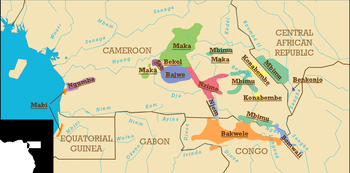Makaa–Njem languages
The Makaa–Njem languages are a group of Bantu languages spoken in Cameroon, the Central African Republic, Equatorial Guinea, Gabon and the Republic of the Congo. They are coded Zone A.80 in Guthrie's classification.
| Makaa–Njem | |
|---|---|
| Geographic distribution | Southern Cameroon and neighbouring areas |
| Linguistic classification | Niger–Congo
|
| Subdivisions |
|
| Glottolog | maka1323[1] |
 The Makaa–Njem languages (excluding Kako) | |
According to Nurse & Philippson (2003), adding the Kako languages (Guthrie's A.90) forms a valid node, called Pomo–Bomwali (Kairn Klieman 1997).
Languages
Makaa–Njem
The Guthrie Makaa–Njem (A.80) languages are:
| Language name | Primary location | Secondary location(s) | Ethnic group(s) | No. speakers[2] | Remarks |
|---|---|---|---|---|---|
| Bekwel | Congo | Cameroon, Gabon | Bekwel | 12,060 | Close to Nkonabeeb and Koonzime. Cameroonian speakers also use Mpongmpong.[3] |
| Bomwali | Congo | Cameroon | Bomwali | 39,280 | |
| Byep | Cameroon | None | Maka | 9,500 | Also called North Makaa, though not intelligible with Makaa.[4] |
| Kol | Cameroon | Gabon | Bekol | 12,000 | Speakers use Makaa or Koonzime as well.[5] |
| Koonzime | Cameroon | None | Badwe'e, Nzime | 30,000 | Badwe'e speak Koozime dialect; Nzime speak Koonzime dialect. Used as a second language by many Baka.[6] |
| Makaa | Cameroon | None | Maka | 80,000 | Related to Byep (North Makaa) and Kol, although unintelligible with them.[7] |
| Mpiemo | Central African Republic | Cameroon, Congo | Mbimu | 29,000 | |
| Mpumpong | Cameroon | None | Nkonabeeb | 45,000 | |
| Ngumba (Kwasio) | Cameroon | Equatorial Guinea | Mabi, Ngumba, Bujeba, Gyele (Koya, Kola) | 22,000 | The Gyele are Pygmies |
| Njyem | Cameroon | Congo | Njyem | 7,000 | Spoken by many Baka as a second language.[8] |
| Swo | Cameroon | None | Swo | 9,000 | High level of influence from Beti.[9] |
| Ukhwejo | Central African Republic | None | Benkonjo | 2,000 |
Maho (2009) adds Shiwe (Oshieba) of central Gabon.
Notes
- Hammarström, Harald; Forkel, Robert; Haspelmath, Martin, eds. (2017). "Makaa–Njem (A.80)". Glottolog 3.0. Jena, Germany: Max Planck Institute for the Science of Human History.
- All totals are based on the relevant Ethnologue pages.
- "Bekwel", Ethnologue.
- "Byep", Ethnologue.
- "Kol", Ethnologue.
- "Koonzime", Ethnologue.
- "Kol", Ethnologue.
- "Njyem", Ethnologue.
- "So", Ethnologue.
gollark: I don't want to be bad to democracy!
gollark: <@263493613860814848> A hazardous apioidal entity.
gollark: So we just have to somehow get more people on *without* randomly pinging them.
gollark: YET.
gollark: I could use my alts, but you would say something about how it's "obviously cheating" and "perverting the course of democracy" and "creates dangerous anomalous apiohazards".
References
- Nurse & Philippson (2003), The Bantu Languages.
- Gordon, Raymond G., Jr. (ed.) (2005). Ethnologue: Languages of the World, 15th ed. Dallas: SIL International. Accessed 7 June 2006.
This article is issued from Wikipedia. The text is licensed under Creative Commons - Attribution - Sharealike. Additional terms may apply for the media files.